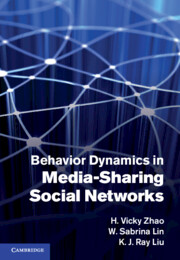Book contents
- Frontmatter
- Contents
- Preface
- Part I Introduction
- Part II Behavior forensics in media-sharing social networks
- Part III Fairness and cooperation stimulation
- Part IV Misbehaving user identification
- Part V Media-sharing social network structures
- 13 Misbehavior detection in colluder social networks with different structures
- 14 Structuring cooperation for hybrid peer-to-peer streaming
- References
- Index
13 - Misbehavior detection in colluder social networks with different structures
from Part V - Media-sharing social network structures
Published online by Cambridge University Press: 28 April 2011
- Frontmatter
- Contents
- Preface
- Part I Introduction
- Part II Behavior forensics in media-sharing social networks
- Part III Fairness and cooperation stimulation
- Part IV Misbehaving user identification
- Part V Media-sharing social network structures
- 13 Misbehavior detection in colluder social networks with different structures
- 14 Structuring cooperation for hybrid peer-to-peer streaming
- References
- Index
Summary
Different social networks may have different structures. The discussions in the previous chapters focused mainly on distributed scenarios. For example, there are no central authorities in the colluder social networks in Chapters 5 and 8, and the P2P systems in Chapters 9 and 12 are fully distributed, meaning that every peer takes the same role. In reality, some social networks have a centralized structure in which there are one or more entities whom all users trust and who can facilitate interaction among users. For example, the first generation P2P file-sharing networks (for example, the Napster music file-sharing system) used a set of central servers to provide content indexing and search services. Although these servers cannot enforce user cooperation, they can facilitate user interaction. Other media-sharing social networks have a distributed structure and a flat topology in which users take the same role – for example, Gnutella and Chord. Distributed schemes should be designed for such social networks. In this chapter, we use colluder social networks in multimedia fingerprinting as an example to investigate the impact of network structure on social networks.
In colluder social networks, as discussed in Chapters 5 and 8, colluders aim to achieve fair collusion, which requires all colluders to report their received fingerprinted copies honestly. As discussed in Chapter 11, the assumption of fair play may not always hold, and some colluders may process their fingerprinted copies before collusion to further lower their risk of being detected.
- Type
- Chapter
- Information
- Behavior Dynamics in Media-Sharing Social Networks , pp. 277 - 307Publisher: Cambridge University PressPrint publication year: 2011



